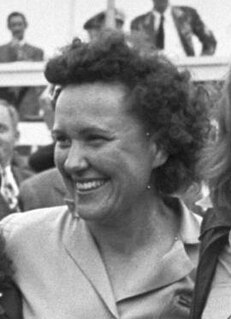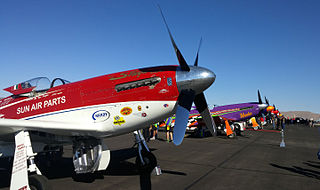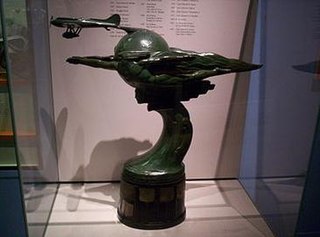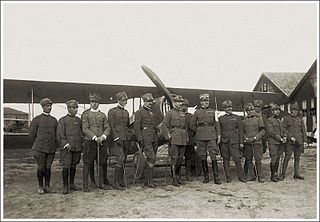History
Inaugurated in 1946, the Halle Trophy Race took place in Cleveland, Ohio, and was named after one of its sponsors, an upscale Cleveland department store. [1] [2] It was one of many events at the National Air Races in Cleveland and the only one limited to women aviators. [3] In the 1946 race, the five women flyers who competed for the first trophy were photographed for Life magazine. [4] The first winner was Marge Hurlburt, who would go on to set a women's air speed record the following year.

Halle Brothers Co. of Cleveland, Ohio, commonly referred to as Halle's, is a defunct department store chain. During most of its 91-year history Halle's focused on higher-end merchandise which it combined with personal service. The company was the first major department store in Cleveland to open a suburban branch store.

The National Air Races are a series of pylon and cross-country races that took place in the United States since 1920. The science of aviation, and the speed and reliability of aircraft and engines grew rapidly during this period; the National Air Races were both a proving ground and showcase for this.

Marge Hurlburt was an American aviator who flew with the Womens Air Service Pilots (WASP) during World War II and set a women's international air speed record in 1947.
The course for the Halle Trophy Race was five laps around a 15-mile course, or 75 miles altogether. [5] [6] The women who flew in the race were limited to modified versions of the North American T-6 Texan, an advanced single-engine plane that had been used to train U.S. pilots during World War II. [5] Preferred models included the AT-6 and the SNJ. Many of the women who took part in this race were veterans of the Womens Air Service Pilots (WASP). [5]

The North American Aviation T-6 Texan is an American single-engined advanced trainer aircraft used to train pilots of the United States Army Air Forces (USAAF), United States Navy, Royal Air Force, and other air forces of the British Commonwealth during World War II and into the 1970s. Designed by North American Aviation, the T-6 is known by a variety of designations depending on the model and operating air force. The United States Army Air Corps (USAAC) and USAAF designated it as the AT-6, the United States Navy the SNJ, and British Commonwealth air forces the Harvard, the name by which it is best known outside the US. Starting in 1948, the new United States Air Force (USAF) designated it the T-6, with the USN following in 1962. It remains a popular warbird aircraft used for airshow demonstrations and static displays. It has also been used many times to simulate various Japanese aircraft, including the Mitsubishi A6M Zero, in movies depicting World War II in the Pacific. A total of 15,495 T-6s of all variants were built.
Halle sponsored the race in 1946 and 1947. [1] [7] Kendall Oil then took over as sponsor of the race, which was renamed the Kendall Trophy Race for 1948 (not to be confused with a men's race of the same name that had been run in 1947). [8] [9]
In 1949, no sponsor could be found, so that year the race was called simply the Women's Trophy Race. The group managing the air races put up a $5,500 purse. New rules were also inaugurated that year, stating that the planes had to keep their stock engines and that wings could not be clipped. Grace Harris won for the second year in a row, but at a much slower speed than in 1948. [10]
In 1950, all of the Cleveland races went on hiatus due to the outbreak of the Korean War, and the women's trophy race went defunct. [11]













